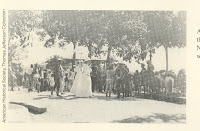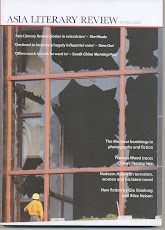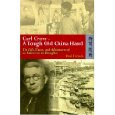Thursday, May 28, 2009
We have moved: Please visit chinarhyming.com!
If you follow China Rhyming via RSS, our new feed is here.
See you at the new site.
Wednesday, May 13, 2009
Deviation Posting: Time for a Good Left-Wing Read

The other day I had a meeting here in Shanghai with a visiting private equity type from America. He was extremely young in a sort of faux-donnish style and extremely right wing which made the non-essential chit-chat rather gruesome. As we parted he gave me a gift – a copy of Ann Rand’s Atlas Shrugged. He assured me that this was helping him through the current hard economic times when he felt his basic values might be challenged by such outrageous hard line socialists as Obama. I was naturally graceful in acceptance though having read it many years ago knew how distasteful I personally found the book and its message. Ho, hum.
Anyway, that got me wondering what classics we should be digging out and then by complete accident (serendipity I guess you’d call it) I came across The Independent’s feature - Black and white and red all over: Left-wing reads.
I’ll assume their first choice – Mao’s Little Red Book – was a joke
Then we get:
2) Robert Tressell’s Ragged Trousered Philanthropists from 1910 which I agree is a timeless classic – it’s been 20 years since I read it so that might be a good one to re-read
3) Franz Fanon’s The Wretched of the Earth from 1961 – ashamed to say have never read
4) Emma Goldman’s Living my Life from 1931 – a great read and reminds us there’s historically been more choice in American politics than the risible differences between Bush and Obama
5) Simone de Beauvoir’s The Second Sex from 1949 – which I personally remember as a bit of a slog
6) Steinbeck’s The Grapes of Wrath from 1939 – which I’m sure reads today as well as the first time I read it as a teenager
7) Gramsci‘s Prison Notebooks from 1929-35 – which I confess to occasionally still dipping into to keep on track
8) Walter Greenwood’s Love on the Dole from 1932 - which remains a classic British novel though rarely read I fear these days
9) Nikolai Chernyshevsky’s What Is To Be Done? From 1862 – which I did read ages ago but none has remained in my mind sadly
10) Radclyffe Hall’s The Well of Loneliness from1928 – never read, sorry
11) Erich Maria Remarque’s All Quiet on the Western Front from 1928 – which dad made us all read as kids to learn to hate war – it worked!
12) Upton Sinclair’s The Jungle from 1906 – which, talking of my dad, is his favourite book and which made a huge impression on me as a kid
13) Zola’s Germinal from 1885 – but then anything from Zola including especially I think La Bete Humaine would do
14) Marx’s Capital from 1867 – still original and best
15) Engels’ The Condition of the Working Class in England from 1845 – which I re-read recently over a long weekend in Manchester and is still great (there’s also an apparently an excellent new biography of Engels out too)
16) Mary Wollstonecraft’s A Vindication of the Rights of Women from 1792 – of course
17) Sidney and Beatrice Webb’s A New Civilisation from 1935 – questionable this one – important at the time certainly; the social engineering and USSR admiration comes over a little trite now though
18) Orwell’s Homage to Catalonia from 1938 – which is of course (as is everything) great and Orwell a God but if it was my list…as a socialist classic Road to Wigan Pier or Down and Out in London and Paris would win out
19) CLR James’ The Black Jacobins from 1938 – a classic from a great man – a socialist who loved cricket – now that’s who should run the world!
20) Rosa Luxemburg’s The Junius Pamphlet from 1916 – fascinating but I’m over by teenage crush on Rosa these days
A very interesting list and only a few I’d add:
Jon Don Passos’ USA – which make a mark on me as a lad
Orwell’s Keep the Aspidistra Flying
Rudolf Rocker’s Anarchism and Anarcho-Syndicalism
Anything by Tony Negri
And probably a few others that’ll come back to me as soon as I’ve posted this!
Tuesday, May 12, 2009
Shanghai Race Club - 75th Anniversary
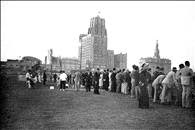
The one thing most people know about old
Anyway, Byron’s also organising Shanghai Race Club Champagne Brunch on Sunday the 17th May (like many modern day Shanghail anders the concept of the Champagne Brunch seems to have an especial appeal – can there by anywhere else where people obsess and get excited about such a thing as Shanghai – I fear not). A bit of promotion for the board game but also to celebrate the 75th Anniversary of the Shanghai Race Club (building and grandstand as seen left). It should be interesting as Peter Hibbard, author of The Bund and
anders the concept of the Champagne Brunch seems to have an especial appeal – can there by anywhere else where people obsess and get excited about such a thing as Shanghai – I fear not). A bit of promotion for the board game but also to celebrate the 75th Anniversary of the Shanghai Race Club (building and grandstand as seen left). It should be interesting as Peter Hibbard, author of The Bund and
Anyway – details of the brunch here – which is being held at Kathleen’s 5 which is on the roof of the old Race Club building (now the Shanghai Art Museum though those with longer memories will remember it as the library and only those with really old memories will now remember it as the Race Club!). Kathleen’s 5 is a rooftop place so you get a view over what was the Race Course, now the morass of People’s Square.
Monday, May 11, 2009
Nazis on the Huang Pu

Of course the series of articles are far from definitive on the subject and, to be fair, you wouldn’t expect that. A full book on the subject remains to be written. There’s also a piece on Dai (Tai) Li and the fascistic Blue Shirts in Shanghai, the major Nazi Party leaders in Shanghai, a tie in with the opening of the new Sino-German movie about John Rabe (who was a Nazi Party member) and (beware plug coming!) an excerpt from my imminently forthcoming book on foreign journalists in China about the Nazi and anti-Nazi press in Shanghai during the period.
Sunday, May 10, 2009
Old Cemeteries, Graveyards and Remains
Of course I’ve visited the vast cemeteries now on Shanghai’s fringes but the downtown cemeteries are all built on. Interestingly no one much, in what can be a very superstitious city, seems bothered by this and I have no idea whether the old graveyards were just churned up or remains taken away. Some of the city’s most notorious buildings sit above former graveyards – the Pearl Oriental Tower must, at least in part, be built over the old Pootung Point graveyard while the fascistic architectural horror that is the JW Marriot at the ridiculously named Tomorrow Square sits on land (according to my old map of Shanghai) that was also a graveyard. Much the same appears to be true of Beijing – I recently went looking for a graveyard noted in an old record but it was firmly gone under the concrete of the Second Ring Road. As far as I could ascertain there was no formal removal of remains to anywhere else.
A few other cemetery related observations noted recently:
I just
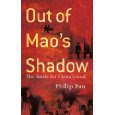 read Philip Pan’s excellent Out of Mao’s Shadow: The Struggle for the Soul of a New China which has a fascinating chapter on a surviving graveyard full of people who died in the Cultural Revolution- that it survived was remarkable; that people were intrigued and cataloguing the dead there a fascinating example of how not everyone accepts that all in China should just forget the CR in the rush to the glory and wonder of total KFCification.
read Philip Pan’s excellent Out of Mao’s Shadow: The Struggle for the Soul of a New China which has a fascinating chapter on a surviving graveyard full of people who died in the Cultural Revolution- that it survived was remarkable; that people were intrigued and cataloguing the dead there a fascinating example of how not everyone accepts that all in China should just forget the CR in the rush to the glory and wonder of total KFCification.I also recently bumped into Dvir Bar-Gal (at an incredibly bad talk by someone on the history of Baghdadi Jews in Shanghai by the way, where the speaker would neither discuss opium, slum landlordism or anything that might have reflected badly on the likes of Sassoon, Hardoon etc – really a very bad example of history as celebrity PR) who has done so much to preserve the Jewish headstones of Shanghai when he can find them. His latest efforts are noted in an article on the JTA website. Dvir notes that, ‘The four cemeteries that once served this city’s (Shanghai’s) small but prosperous Jewish community disappeared in the late 1960s during China’s Cultural Revolution. The sites were paved over to build a factory, park, hotel and Muslim cemetery, their history forgotten.’
Saturday, May 9, 2009
The Gurkhas, Justice and a National Embarrassment

It’s hard to be anything but disgusted with the British government’s attitude to the Gurkha’s and the pension row. The history of the Gurkas as fighting men in the pay of
From the end o f the Indian Rebellion of 1857 until the start of the First World War the Gurkha Regiments saw active service in
f the Indian Rebellion of 1857 until the start of the First World War the Gurkha Regiments saw active service in
For the purposes of this blog it’s worth remembering that the Gurka’s also saw active service in China during the Boxer Rebellion in 1900 (Gurkhas in China are pictured left) and Tibet during Younghusband's bloody Expedition of 1905. I’m not going to argue whether or not any of the wars above were politically acceptable – the Gurkha’s were a key part of the military arm of the
There is a campaign currently running to support Gurkhas and pressure the  nasty little self-centred careerist when he was head of the National Union Students in my college days - a real horrible little greasy pole climber who obviously hasn't changed one jot) continues to prevaricate and pettifog.
nasty little self-centred careerist when he was head of the National Union Students in my college days - a real horrible little greasy pole climber who obviously hasn't changed one jot) continues to prevaricate and pettifog.
If you want to support the campaign for full Gurkha Justice – on their site you can sign the petition calling calling on the UK Government to act immediately to change the law to allow all retired Gurkhas the right to stay in the
Friday, May 8, 2009
Nanjing Massacre Films
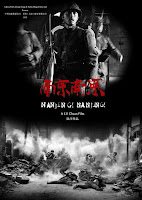
Two films are doing the rounds at the moment concerned with the Nanjing Masscare of 1937 - Lu Chuan's City of Life and Death, from the point of view of the city's military defense, civilian refugees, and Japanese invaders, and John Rabe, a Sino-German production, looking at the Massacre through the experiences of the title character, a German businessman with Siemens and Nazi Party member in China who helped set up a refugee zone in the city.
I haven't
 had a chance to see either film - and may well never see either as I don't watch TV much and never go to the cinema. Still they're hard to ignore and should be interesting one way or another for the reaction to them in China. Danwei has a post on both films and some initial reactions which I'll just link to for now.
had a chance to see either film - and may well never see either as I don't watch TV much and never go to the cinema. Still they're hard to ignore and should be interesting one way or another for the reaction to them in China. Danwei has a post on both films and some initial reactions which I'll just link to for now.Thursday, May 7, 2009
Images of American Colonialists in the Philippines
Anyway here they are – Americans trying to be colonials circa 1905:
Wednesday, May 6, 2009
Clarification on the Tunsin
My musings on the old
 d have a ship called Tunsin which was originally owned by a company called George Barnet & Co. of Shanghai - Tunsin was their Hong name meaning that the street may have been named after the Hong rather than the vessel – this is actually more likely as several other streets in Shanghai were named after Hong names – Jinkee Road (now Dianchi Lu) after the Hong name of Gibb, Livingstone (their building on the road is left) and Chaoufoong Road (now Gaoyang Lu) after the Hong name of Jenner Hogg & Co.
d have a ship called Tunsin which was originally owned by a company called George Barnet & Co. of Shanghai - Tunsin was their Hong name meaning that the street may have been named after the Hong rather than the vessel – this is actually more likely as several other streets in Shanghai were named after Hong names – Jinkee Road (now Dianchi Lu) after the Hong name of Gibb, Livingstone (their building on the road is left) and Chaoufoong Road (now Gaoyang Lu) after the Hong name of Jenner Hogg & Co.
 London, supposedly as a blockade runner for use in the American Civil War, but was purchased half-built by Barnets, arriving in Shanghai in May 1864 and placed in service on the Yangtze. In March 1867 the Tunsin was sold to F.A. Groom, for a Chinese syndicate, managed by Glover & Co. In July 1867 she was transferred to Union S.N.Co. (Glovers also managers) and in 1873 sold to CNCo. In 1885, CNCo converted the ship to a hulk for use as a landing stage at Swatow (
London, supposedly as a blockade runner for use in the American Civil War, but was purchased half-built by Barnets, arriving in Shanghai in May 1864 and placed in service on the Yangtze. In March 1867 the Tunsin was sold to F.A. Groom, for a Chinese syndicate, managed by Glover & Co. In July 1867 she was transferred to Union S.N.Co. (Glovers also managers) and in 1873 sold to CNCo. In 1885, CNCo converted the ship to a hulk for use as a landing stage at Swatow (
Tuesday, May 5, 2009
Why Old Shanghai's Tunsin Road was Called Tunsin Road

I think I now know the answer. The likeliest answer seems to be that when John Swire (left), the Yorks
 hire-born tycoon who had founded Taikoo Sugar, came to Shanghai, he saw the potential for steam shipping on the Yangtze River - then the West's only key to trade with China's interior. With the backing of Alfred Holt, and the latter's Clyde shipbuilder back in Glasgow, Scotts’ Shipbuilding & Engineering Company, Swire formed The China Navigation Company (CNCo) - registered in London and with Butterfield & Swire appointed managers in Shanghai.
hire-born tycoon who had founded Taikoo Sugar, came to Shanghai, he saw the potential for steam shipping on the Yangtze River - then the West's only key to trade with China's interior. With the backing of Alfred Holt, and the latter's Clyde shipbuilder back in Glasgow, Scotts’ Shipbuilding & Engineering Company, Swire formed The China Navigation Company (CNCo) - registered in London and with Butterfield & Swire appointed managers in Shanghai.Swire immediately ordered three Mississippi-style paddle steamers for the new company. But even before these vessels - Peking, Shanghai and Ichang - had arrived in China, he had snapped up the assets of a newly bankrupted line, Union Steam Navigation, which provided valuable waterfront properties along the Yangtze, as well as two steamers. USNCo’s veteran Tunsin (pictured above) was thus destined to become the first vessel to sail under the Swire flag in 1873.
Seems to fit.
Monday, May 4, 2009
Anniversaries - May Fourth 1919 – Who Covered it for the Foreign Press Then?

This incredible year of anniversaries in China rolls on today. It can be argued that modern China really began, or at least showed itself formed to a degree, on 4th May 1919 with the protests following China’s disappointment after its betrayal at the Versailles Peace Conference. Despite pledges that every country would be represented, China was not. The European Great Powers and America did not apply any more than cursory pressure on China’s behalf and Japan retained the “special rights” it had snatched from the Germans in Qingdao and Shandong.
The seats at Versailles reserved for the Chinese delegation were never occupied and the Chinese decided not to sign in protest against the clauses in the treaty agreeing to the transfer of German leaseholds to Japan. On 4 May, angered at the betrayal and fired up with a justified nationalist fervour, radicalised students staged largescale demonstrations across China. These were the first mass protests in modern Chinese history (as in Peking left) and in many ways set the hallmark for the 1920s as a decade of domestic protest and internal unrest — what became known as the May Fourth Movement.
Among the foreigners who actually observed the 4th May events a few stand out as interesting I think. Not least Dr. Paul Reinsch, the US minister to China. Reinsch, who was generally pro-Chinese, had been angered by Japan’s 21 Demands on China during WW1. He felt personally compromised by America’s lack of support for China in Paris despite Wilson’s pledges and resigned in 1919 to take up a post advising the Chinese government in Washington. The great Bill Donald – Donald of China - who was briefly editing the Far Eastern Review penned a lengthy editorial sympathetic to the May Fourth Movement.
Also interesting was the pioneering American missionary Frank J. Rawlinson, who developed a brand of liberal Protestantism after becoming involved in the May Fourth Movement. Rawlinson had been born into a Plymouth Brethren family but arrived in China in 1902 as a Southern Baptist missionary and remained based in Shanghai for his entire career until his death in 1937. After becoming radicalised, he split with the Southern Baptists and joined the American Board of Commissioners for Foreign Missions. In 1914 he became the editor of the interdenominational Chinese Recorder, which under his tutelage reflected his liberal and often outspoken views forged in 1919.
I think the best foreign chronicler of the May Fourth Movement at the time was Pennsylvanian native and Harvard graduate Rodney Yonkers Gilbert, who had come to China as a medicine salesman in 1912 before becoming a long-standing Beijing-based reporter for the North-China Daily News. Gilbert covered the May Fourth demonstrations in the city and attended the lively and raucous meetings held at Peking University. He seemed to be broadly supportive of the student’s anti-Japanese stance, or at least applauded their decision to organize and take action, writing: “The advertisement given to this gathering inspired the local students to do something on their own account, and whatever one thinks of the action they eventually took they certainly deserve full credit for being the first in China to substitute action for talk”.
However, Gilbert was an extremely contradictory character. His initial enthusiasm would later become tempered with cynicism. He concluded his 1926 book What’s Wrong with China, which was widely read at the time, with the passage: “We have therefore to be grateful to the firebrand element in China which is driving furiously on towards the complete ruin of China as a nation, the utter collapse of foreign trade with this bad-boy people, and very possibly the martyrdom of those of us who are foolish enough to live in China: and out of great weariness of the spirit and something like Petronian good cheer in the face of what is coming, our toast is: ‘More power to their elbows!”’
I’d also note Joseph Washington Hall in Tianjin for May 4th. Hall worked for the American Legation’s espionage service in Shandong from 1916 to 1919. He left the service in time to observe the student protests in Tianjin, which he supported, as a journalist. He freelanced for the China Weekly Review and as a Beijing correspondent for the China Press using the penname Upton Close.
Sunday, May 3, 2009
The Industrial Penetration of China in 1925

Picked up a copy of a map from 1925 the other day entitled The Industrial Penetration of China. It was produced in the
By the wonders of modern science if you click on the image it becomes larger and clearer.
It’s rather confusing though does indicate some interesting facets – the clearly highly important role of Hankow as a centre of ironworks, flour mills and cotton mills and the heavy concentration of electricity plants around Shanghai and eastern China gives a good indication of where people had access to electricity – no wonder the Socony men heroes of Alice Tisdale Hobart’s Oil for the Lamps of China were all sent deep into the hinterland. Wusih (
Saturday, May 2, 2009
Carl Crow’s Final Resting Place

As my new book is out soon (look at the left hand column for details) I feel it’s time to finish of the last few bits of Carl Crow stuff I’ve got lying around. Carl pops up in the new book as it is a history of the old China press corps but not too much to avoid repetition. It’s also the case that I have edited Carl’s diaries from his Burma Road trip in 1939 from Rangoon to Chungking and they’ll hopefully be published later in the year (autumn probably).
While I was researching the book a friend in America was good enough to track down Carl’s grave. I knew that Carl had died at his apartment on Washington Place, New York City on the 8th June 1945
 of cancer. He was then transferred to the Walter B Cooke Funeral Home on West 72nd Street, Manhattan, for final internment at the Odd Fellows Cemetery on Main Street, Fredericktown, Missouri, where he was eventually buried next to his mother and father. His final instructions were for no flowers but all contributions to be sent to the American Society for the Control of Cancer. Carl was originally from Missouri and this was his wish.
of cancer. He was then transferred to the Walter B Cooke Funeral Home on West 72nd Street, Manhattan, for final internment at the Odd Fellows Cemetery on Main Street, Fredericktown, Missouri, where he was eventually buried next to his mother and father. His final instructions were for no flowers but all contributions to be sent to the American Society for the Control of Cancer. Carl was originally from Missouri and this was his wish.Unfortunately I could never quite find the time, money or a decent excuse to get to Fredericktown. Still a friend helped while passing close by. He found the Odd Fellows Cemetery and Carl’s grave as you can see in the pictures. It looks a peaceful place.
Friday, May 1, 2009
May 1 - International Workers' Day

For those, like me, who grew up on the Left – today is the big one – May 1 - International Workers' Day. Of course the holiday in its leftist incarnation arose after the first nationwide General Strike in
 As far as I’m concerned the best known image for May Day is Walter Crane’s poster – left. Born in
As far as I’m concerned the best known image for May Day is Walter Crane’s poster – left. Born in
I’m glad to see that other authors and artists keep the tradition of political posters alive still. I particularly like (and it’s relevant to this blog I guess) the poster by Micah Wright – left - a clever parody of an old WW2 propaganda poster.
see that other authors and artists keep the tradition of political posters alive still. I particularly like (and it’s relevant to this blog I guess) the poster by Micah Wright – left - a clever parody of an old WW2 propaganda poster.
German Tsingtao Flag

Coming across the old flags of Weihaiwei yesterday I also came across the flag that used fly over Tsingtao (Qingdao). A bit of a different story here. The Kiautschou territorywas leader in 1898 to Germany for 99 years – Tsingtao being the main town (left: German troops on parade in Tsingtao). It was popular with the Germans, nice climate, popular holiday destination for foreigners in the China treaty ports and also a base for the German fleet that looked after the Kaiser’s rather disparate and cobbled together Pacific empire that they kept until World War One – people forget now German New Guinea, the German Solomon Islands, Nauru, the Marshall Islands, the Caroline Islands and German Samoa). Anyway, in 1918 Tsingtao was transferred to Japan.
The Germ
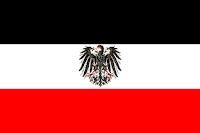 ans never actually designed a specific flag for Tsingtao but they did use the so-called flag of the German colonies - horizontal black-white-red with the Imperial eagle without crown in the middle of the white stripe.
ans never actually designed a specific flag for Tsingtao but they did use the so-called flag of the German colonies - horizontal black-white-red with the Imperial eagle without crown in the middle of the white stripe.
Thursday, April 30, 2009
Flags of British Weihaiwei

Posting about British rule in Weihaiwei yesterday led me to come across the old flags of Weihaiwei during the British years. I’d never thought about Weihaiwei having a flag before, but they did.

From 1899 to 1902 they used the so-called flag of the Commissioner of Liu Kung Tau/Weihaiwei (above) and blue ensign version (left) for shipping.
Then in 1902 a purely Civil Commissioner, J.H. Stewart Lockhart, was appointed who wrote to London declaring, “The design of the flag hitherto used by the Commissioner of this Dependency is a dragon on the Union Jack and is in my opinion quite unsuitable. I have therefore to request that the Crown Agents may be instructed to have made for the use of the Commissioner two new flags, the device of the Mandarin Duck being substituted for the Dragon, which is as you are aware the national emblem of China and not appropriate in the case of a British Dependency.”
The Mandarin Duck design (they are both ducks), which was part of the Seal, was approved by King Edward VII
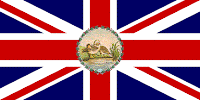 at some time in 1903. Apparently reflecting native wildlife to that area.
at some time in 1903. Apparently reflecting native wildlife to that area.
 So then they appear to have used the flag left and the blue ensign version for shipping.
So then they appear to have used the flag left and the blue ensign version for shipping.
All quite confusing so I might have got this a bit wrong. If anyone knows better do let me know.
Wednesday, April 29, 2009
Weihaiwei – The British, Kangaroo Courts and the Llandudno of China!
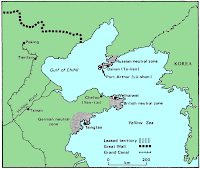
Weihaiwei, now more simply Weihai, seems to be very popular at the moment with any number of books and papers appearing on the place. Fair enough as it is an interesting place given that it was neither a full colony or a treaty port but rather a leased piece of land – the lease lasted as long as the Russians were in Port Arthur to maintain the balance of Great Power influence (the Americans were very keen for the British to be stationed at Weihaiwei) though China never surrendered sovereignty on the land.
The administration of Weihaiwei involved several interesting characters including Reginald Johnston (Pu Yi’sold tutor) and JH Stewart Lockhart. Weihaiwei’s legal system including some interesting murder cases is the subject of a new book by Carol Tan of SOAS called British Rule in China: Law and Justice in Weihaiwei: Law and Justice in Weihaiwei 1898 – 1930. Sadly it’s a bit expensive and in hardback only so hopefully you’ve got a decent library near you. Carol also gave an interesting talk to the Royal Asiatic Society in
However, I personally wasn’t convinced that anything like an even negligibly acceptable level of justice was available in British Weihaiwei – the jury pool was tiny and meant both the same people constantly being on juries and, inevitably, defendants being known to jurors while lawyers were sparse. Even worse we are presented with the joke of the horrendously self-important Reginald Johnston believing none of this was a problem as he had some sort of Confucian ability to adjudicate without legal training, being a local or any decent juries. Academics are nice people who don’t like to judge – even when looking at history – but of course there is no other conclusion than that the legal system and the British courts in Weihaiwei were nothing more than kangaroo courts and merely devices for maintaining British rule.
One interesting thing I didn’t know was the silly comparisons people made with Weihaiwei. I’ve noted daft foreigners comparing places in
Tuesday, April 28, 2009
Junk Sunk

Deviation Posting – Recession and 1945
 gies for quick deviation into British history and politics today but I got a bit narked listening to the radio. The newspapers, radio and TV have quickly latched on to this idea that the recession is now the worst since World War Two in Britain. Maybe, maybe not. Politicians in the UK have decided that this means they can say that the economy (and by extension they claim life in general) is as bad as it was in 1945. This is of course nonsense and one of those arguments only possible in a world where people don’t read enough history.
gies for quick deviation into British history and politics today but I got a bit narked listening to the radio. The newspapers, radio and TV have quickly latched on to this idea that the recession is now the worst since World War Two in Britain. Maybe, maybe not. Politicians in the UK have decided that this means they can say that the economy (and by extension they claim life in general) is as bad as it was in 1945. This is of course nonsense and one of those arguments only possible in a world where people don’t read enough history.Indeed to argue that anything now is like 1945 is so daft that any politician you hear mentioning this comparison should immediately have ensured you’ll never vote for them again. Just consider the picture of the Gorbals in Glasgow (which appears in David Kynaston’s excellent book noted below) above – now while the Gorbals is still far from paradise, whatever it is it isn’t anything like this anymore, the people who live there are different, the jobs they do (or don’t do) completely changed etc. In 1945 Britain was victorious but bombed out and knackered, rationing was in place, shortage widespread, the Treasury bust in a way it isn't now – to compare 2009 to 1945 is bizarre – sound bite politics I guess. Below I’ve noted a couple of books that describe that time excellently from David Kynaston and Maureen Waller that are well worth a read.
However, one thing about 1945 is instructive and we could learn from it. Right now it seems that we’re just going to let the same politicians and bankers that broke their own system put it back together way they like and that suits them best. This would be a tragedy. In 1945 Britain rejected the Tories as a party of the past (they were then, they are now) and elected a government that launched a programme of broadly socialist egalitarian ideas – the NHS, extensive nationalisation, education and housing. Politicians can try and score points by evoking images of 1945 and ruin; they might want to remember what arose from those ruins based on the idea of taking control of an economic system for the good of the many rather than just a financial elite. And, oh yeah, while I'm on a rant, bring back imperial measurements.

Austerity Britain, 1945-1951 - David Kynaston

London 1945 – Maureen Waller
Monday, April 27, 2009
A Few Posts on Keelung VI - Ershawan Fort

The fort was s
As you can see it did offer a rather good view of the entrance of the harbour.
Sunday, April 26, 2009
Why Empire of the Sun was Important

Since JG Ballard’s death recently I’ve heard a lot of people on the radio, in print and in casual conversations praise Ballard’s Empire of the Sun. Perhaps the conversations are not that surprising as I’m in
Personally I’ve never actually thought Empire of the Sun was a great book – at least not within Ballard’s overall cannon which contains several more important and greater works notably Crash (1973) and his other dystopian novels of the British new wave (a wave he largely created).
In this sense Empire is an aberration rather than the norm in terms of Ballard’s work. A "novel",
though obviously based on Ballard’s own experiences, rather than an autobiography and not intended as a a reliable historical text. Indeed Ballard never claimed it should be used as such (when other internees disputed his book he had to point this out repeatedly to peopel who refused to see the word "novel" on the cover) and insisted the words ‘A Novel’ appeared on the cover. Of course Spielberg’s film (and it’s hard to imagine the Hollywood engendered Spielberg liking anything else of Ballard’s – surely he would have been put off by the "adultness" and remorseless downbeat nature of his fiction) further removed the book from any reality with the rather annoying insertion of several scenes not in the book that seem to add nothing except a certain late twentieth century political correctness Spielberg is of course noted for.
So if it’s no t exactly a great book why is it important? It seems to me that Ballard’s stark dystopian literature, his nervousness of the culture of consumption and general social vacuity are best understood
t exactly a great book why is it important? It seems to me that Ballard’s stark dystopian literature, his nervousness of the culture of consumption and general social vacuity are best understood
through the prism of his wartime experiences. That’s why reading Empire (and his decidedly less commonly read, but arguably more revealing, follow up The Kindness of Women, published in 1991) is important – not to learn anything about Shanghai (which you won’t unless you know absolutely nothing about the place and time, in which case sue your history teachers) or particularly Ballard’s experiences or feelings at the time (Jim is not him he was always keen to point out and says little about the situation either personally or politically) but to better understand the roots of Ballard’s incredibly important fiction that he wrote after he returned to England.
I think Ballard himself saw Empire this way. In one of his last interviews with the BBC he discussed his youthful experiences. Ballard accepted that of course his fiction would have been totally different if he had not undergone the unpleasantness of inte rnment in
In Shanghai Ballard learnt the essential surrealism of life – he remembers walking the previously neat and prosperous streets and seeing cars on their roofs (the bomb that fell outside the Cathay Hotel left), apartment buildings shattered to reveal their innards of 20 living rooms and 20 private lives that weren't meant to be on public display and of course dead bodies littering the pavement (both the starved and the bombed). Ballard believed that the war had made him nervous of bland reassurances that everything was all right and that when anyone told him everything was “all right”, it was invariably anything but. As he said, ‘reality is a stage set that can be swept aside, as I saw as a boy in
Clearly that loss of one privileged life for another dystopian one is key as was (and noted in The Kindness of Women) the unexpected death of Ballard’s wife at a young age that left him a widower with three children to care for) proved to him the transient and temporary nature of everyday seemingly constant reality.
What else d id he take from his
id he take from his
Interestingly I think one of the most important things he took from Shanghai that became a recurrent theme for him - the human struggle within a consumerist landscape – ended in 1937 but has come back to haunt the city as the post-1949 powers that be encourage consumption over spirituality and shopping as the great ideology-religion-culture to end all others and to negate opposition or disgruntlement with one's lot in life.
It was these experiences that shaped Ballard’s incredible fiction and therefore why reading Empire of the Sun and The Kindness of Women remains important. The interesting thing to ponder is quite how Ballard partly predicted the descent of



